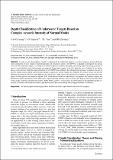Depth classification of underwater targets based on complex acoustic intensity of normal modes
Author(s)
Yang, Guang; Yin, Jingwei; Yu, Yun; Shi, Zhenhua
Download11802_2016_Article_2674.pdf (497.5Kb)
PUBLISHER_POLICY
Publisher Policy
Article is made available in accordance with the publisher's policy and may be subject to US copyright law. Please refer to the publisher's site for terms of use.
Terms of use
Metadata
Show full item recordAbstract
In order to solve the problem of depth classification of the underwater target in a very low frequency acoustic field, the active component of cross spectra of particle pressure and horizontal velocity (ACCSPPHV) is adopted to distinguish the surface vessel and the underwater target. According to the effective depth of a Pekeris waveguide, the placing depth forecasting equations of passive vertical double vector hydrophones are proposed. Numerical examples show that when the sum of depths of two hydrophones is the effective depth, the sign distribution of ACCSPPHV has nothing to do with horizontal distance; in addition, the sum of the first critical surface and the second critical surface is equal to the effective depth. By setting the first critical surface less than the difference between the effective water depth and the actual water depth, that is, the second critical surface is greater than the actual depth, the three positive and negative regions of the whole ocean volume are equivalent to two positive and negative regions and therefore the depth classification of the underwater target is obtained. Besides, when the 20 m water depth is taken as the first critical surface in the simulation of underwater targets (40 Hz, 50 Hz, and 60 Hz respectively), the effectiveness of the algorithm and the correctness of relevant conclusions are verified, and the analysis of the corresponding forecasting performance is conducted.
Date issued
2016-02Department
Massachusetts Institute of Technology. Department of Mechanical EngineeringJournal
Journal of Ocean University of China
Publisher
Science Press
Citation
Yang, Guang et al. “Depth Classification of Underwater Targets Based on Complex Acoustic Intensity of Normal Modes.” Journal of Ocean University of China 15.2 (2016): 241–246.
Version: Author's final manuscript
ISSN
1672-5182
1993-5021